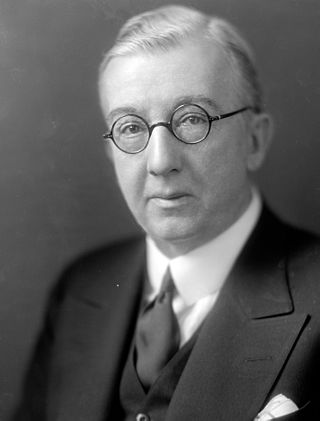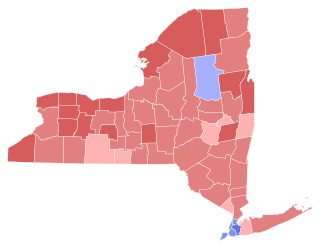
The 1964 United States Senate elections were held on November 3. The 33 seats of Class 1 were contested in regular elections. Special elections were also held to fill vacancies. They coincided with the election of President Lyndon B. Johnson by an overwhelming majority, to a full term. His Democratic Party picked up a net two seats from the Republicans. As of 2023, this was the last time either party has had a two-thirds majority in the Senate, which allowed the Senate Democrats to override a veto, propose constitutional amendments, or convict and expel certain officials without any votes from Senate Republicans. However, internal divisions would have prevented the Democrats from having done so. The Senate election cycle coincided with Democratic gains in the House in the same year.

The 1946 United States Senate elections were held November 5, 1946, in the middle of Democratic President Harry S. Truman's first term after Roosevelt's passing. The 32 seats of Class 1 were contested in regular elections, and four special elections were held to fill vacancies. The Republicans took control of the Senate by picking up twelve seats, mostly from the Democrats. This was the first time since 1932 that the Republicans had held the Senate, recovering from a low of 16 seats following the 1936 Senate elections.

The 1928 Republican National Convention was held at Convention Hall in Kansas City, Missouri, from June 12 to June 15, 1928.

Royal Samuel Copeland, a United States Senator from New York from 1923 until 1938, was an academic, homeopathic physician, and politician. He held elected offices in both Michigan and New York.

Alanson Bigelow Houghton was an American businessman, politician, and diplomat who served as a Congressman and Ambassador. He was a member of the Republican Party.

The 1938 New York state election was held on November 8, 1938, to elect the governor, the lieutenant governor, the state comptroller, the attorney general, two U.S. Senators and two U.S. Representatives-at-large, as well as all members of the New York State Assembly and the New York State Senate. The 1938 election was the first election where the Governor of New York was elected to a four-year term, rather than a two-year term.

The 1928 New York state elections were held on November 6, 1928, to elect the governor, the lieutenant governor, the state comptroller, the attorney general, a U.S. Senator and a judge of the New York Court of Appeals, as well as all members of the New York State Assembly and the New York State Senate.

The 1922 New York state election was held on November 7, 1922, to elect the governor, the lieutenant governor, the Secretary of State, the state comptroller, the attorney general, the state treasurer, the state engineer and a U.S. Senator, as well as all members of the New York State Assembly and the New York State Senate. Two amendments to the State Constitution were also proposed. During his 1922 reelection bid, Smith notably embraced his position as an opponent of Prohibition.

The 1896–97 United States Senate elections were held on various dates in various states. As these U.S. Senate elections were prior to the ratification of the Seventeenth Amendment in 1913, senators were chosen by state legislatures. Senators were elected over a wide range of time throughout 1896 and 1897, and a seat may have been filled months late or remained vacant due to legislative deadlock. In these elections, terms were up for the senators in Class 3.

The 1892–93 United States Senate elections were held on various dates in various states, coinciding with former Democratic President Grover Cleveland's return to power. As these U.S. Senate elections were prior to the ratification of the Seventeenth Amendment in 1913, senators were chosen by state legislatures. Senators were elected over a wide range of time throughout 1892 and 1893, and a seat may have been filled months late or remained vacant due to legislative deadlock. In these elections, terms were up for the senators in Class 1.

The United States Senate election of 1930 in Massachusetts was held on November 4, 1930. Incumbent Republican Senator Frederick H. Gillett did not run for re-election. In the open race to succeed him, Democratic Mayor of Fitchburg Marcus A. Coolidge defeated former U.S. Senator William M. Butler.

The 1932 United States Senate election in Connecticut was held on November 8, 1932.

The 1914 United States Senate election in New York was held on November 3. Incumbent Republican Senator Elihu Root chose not to seek re-election. James Wolcott Wadsworth Jr. was elected to a succeed Root, defeating Democrat James Watson Gerard.

The 1934 United States Senate election in New York was held on November 6, 1934, to elect a U.S. Senator. Incumbent Democratic Senator Royal Copeland was re-elected to a third term in office, though he would die in office in 1938.

The United States Senate election of 1922 in New Jersey was held on November 7, 1922.

The 1924 United States Senate election in New Jersey was held on November 4, 1924. Incumbent Republican Senator Walter Evans Edge was re-elected to a second term in office. He would not complete the term, resigning from office in 1929 to be sworn in as the U.S. Ambassador to France.

The 1926 United States Senate election in Connecticut was held on November 2, 1926.

The United States Senate election of 1928 in New Jersey was held on November 6, 1928. Incumbent Democratic Senator Edward I. Edwards ran for re-election to a second term in office, but was defeated by Hamilton Fish Kean in a landslide. This was the third of four straight elections to this seat in which the incumbents were defeated.

The 1922 United States Senate election in New York was held on November 7, 1922. Incumbent Republican Senator William Calder ran for re-election to a second term, but was defeated by Democrat Royal Copeland.

The 1940 United States Senate election in New York was held on November 5, 1940. Incumbent Democratic Senator James M. Mead, first elected in 1938 to fill vacancy caused by the death of Royal S. Copeland, was re-elected to a full term in office, defeating Republican Bruce Barton.





















